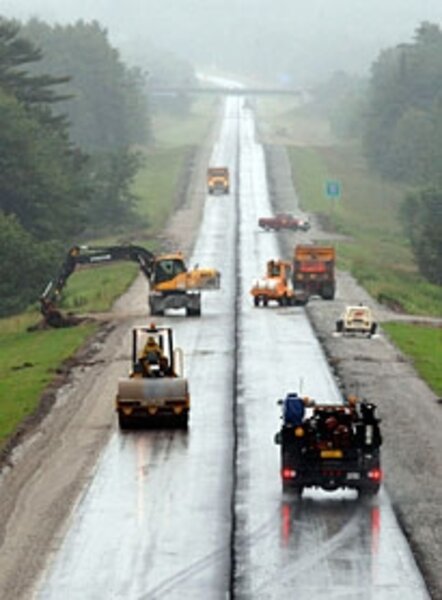Drivers face delays from 2,000 stimulus-funded projects
Loading...
| New York
If you've been stuck in traffic recently because construction has closed off lanes, blame Washington. But this winter, when you’re not hitting potholes, you can thank Washington.
Because of the economic stimulus package, motorists are likely to see more of those orange traffic cones this summer. Places from Minneapolis to Rochester, N.Y., seem to have permanent “flagmen” warning of what's ahead. In some cities, it will be almost impossible to avoid delays.
“We’re seeing an intersection of the peak summer driving season – July and August – combined with an influx of stimulus-related funding for construction,” says Troy Green, a national spokesman for AAA in Washington. “It means this summer will probably be busier than normal for road construction.”
Nationwide, 2,000 stimulus-funded construction projects are under way, and another 5,600 have been approved for bidding, the American Association of State Highway and Transportation Officials (AASHTO) estimated last Tuesday.
“That means every day, the number of projects under way will go up,” says Tony Dorsey, an AASHTO spokesman. “We will pretty much see it all over the country.”
Initially, some motorists will see more of it than others. Utah, Oklahoma, and Maine plan to have under contract this summer 100 percent of their highway stimulus funds. Another 15 states plan to have 80 percent of their funding contracted out this summer, Mr. Dorsey says.
Construction officials, eager for the work, are playing down the prospect of construction delays. Budget cutbacks at the state level, they say, had already reduced the number of summer construction projects.
“The level of work is no more than the past in the summer – and in some states less because of a drop in state revenues,” says Ken Simonson, chief economist for the Associated General Contractors of America.
Unlike some construction that seems to drag on for months at a time, Mr. Simonson says, much of the construction this summer will be to fill potholes or perhaps repave sections of highway. “The emphasis is on shovel-ready,” he says, “So what’s being done is quicker than adding a lane or replacing a bridge.”
Still, drivers would probably benefit from doing more planning to avoid bottlenecks, traffic experts say. Mr. Green, for example, suggests that AAA members call for a TripTik, a route planner that includes the latest construction projects. “It allows you to plan and select alternatives or allot extra time,” he says.
Some state departments of transportation say they are trying to go out of their way to inform drivers about potential delays. Minnesota, which has a large amount of construction, uses its DOT website and will alert drivers via e-mail about specific projects.
In some cities, it’s almost impossible to avoid some kind of delay. That seems to be case in Rochester, where all three Interstates that pass through the city are now construction zones.
This has led Rochester resident Charla Stevens Kucko to search for alternative routes on local streets. “It’s stop-and-go because you do have traffic lights,” says Ms. Kucko, who notes that she gets especially annoyed when traffic is funneled to a single lane but she sees no work being done on the closed lanes. “Maybe they are doing night work, but it’s maddening."





